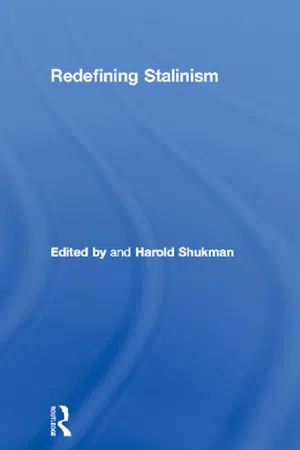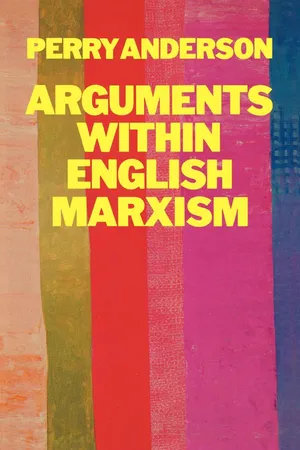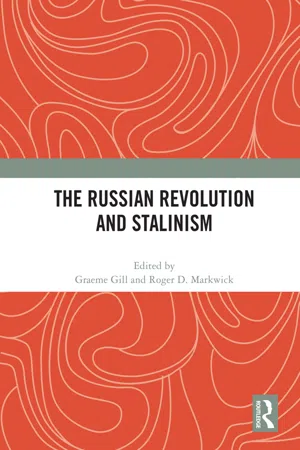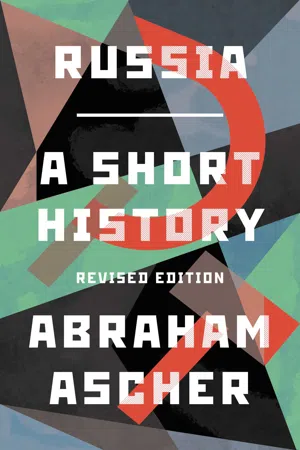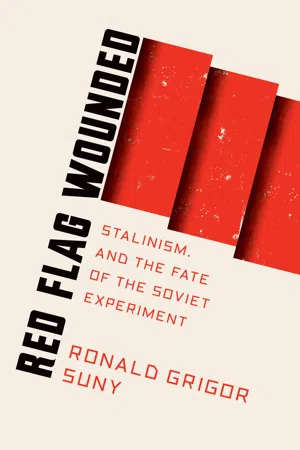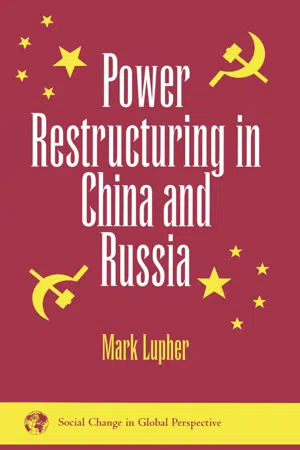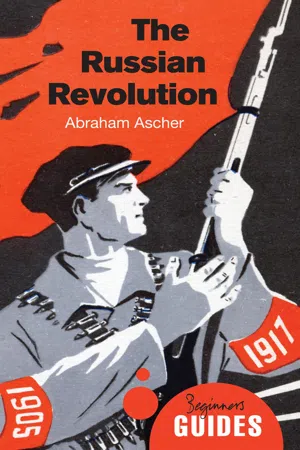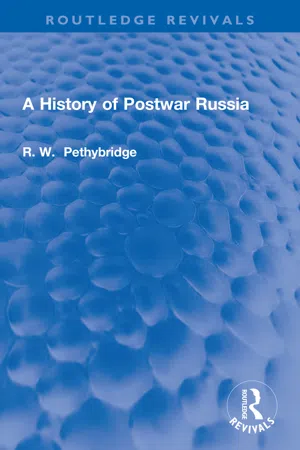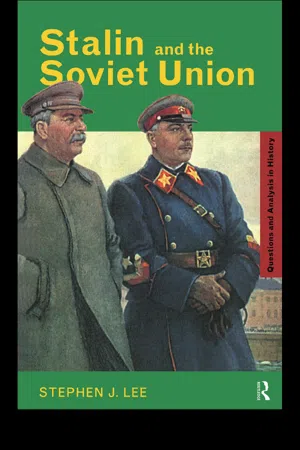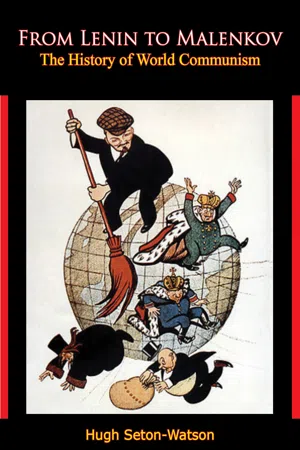Politics & International Relations
Stalinism
Stalinism refers to the political and economic policies, as well as the cult of personality, associated with Joseph Stalin's leadership of the Soviet Union from the late 1920s until his death in 1953. It is characterized by centralized control, authoritarianism, forced industrialization, collectivization of agriculture, and widespread use of state terror. The term also encompasses the pervasive propaganda and censorship that defined the era.
Written by Perlego with AI-assistance
Related key terms
11 Key excerpts on "Stalinism"
- eBook - ePub
- Paul G. Lewis(Author)
- 2014(Publication Date)
- Routledge(Publisher)
CHAPTER FOUR The Politics of Stalinism Stalinism AND THE ECLIPSE OF NATIONAL COMMUNISMThe unity of the Soviet bloc was progressively strengthened following the establishment of the Cominform in 1947. Internal political uniformity within the Central European states was enforced with the amalgamation of the communist and remaining socialist parties in 1948 and the elimination of any lingering political significance attached to the government coalitions that survived. Although the different areas of Central Europe had been exposed to Soviet influence and experienced the rigours of communist dictatorship well before 1947, the establishment of Stalinism as an international system encompassing the region can be dated from the middle of that year. Its onset meant the strengthening and more direct exercise of Soviet power within Central Europe; growing uniformity and social regimentation; stronger central control over political and all social organizations (involving purges of their membership) the development of mechanisms of detailed surveillance; greater repression and ultimately terroristic intimidation of the population; growing prominence of the leadership cult, both around Stalin and national leaders; and policy changes which involved the acceleration of industrial development and collectivization of agriculture.The imposition of Stalinism in Central Europe contained its own paradoxes, however. As one-party communist rule became firmly established the party became less significant as an institution – its discussions and meetings were ridiculously formal, official internal procedures fell into disuse and governing bodies ceased to meet, while members – and particularly many of its leading personnel – were increasingly subject to police surveillance and victimization. Ideological dogma and mass propaganda monopolized public life, but they evoked little positive response among the population and carried less and less credibility. Constant propaganda and official enthusiasm produced private cynicism; the promotion of international communist amity was accompanied by growing national isolation and fostered popular resentment; and many Central Europeans became disillusioned and bitter about the outcome of the ‘liberation’ they had so recently experienced. When possible, individuals tended to retreat from public life and protect the values and private interests that remained to them. The atmosphere this created struck party activist and Comintern agent Adam Rayski on his return to Poland from France in the early 1950s: ‘Man was degraded. The harshness of the everyday battle for life carried him back several centuries … An egocentrism which had nothing in common with the individualism of bourgeois society and was rent by the laws of competition dominated everyday relations.’1 By the time George Orwell’s Nineteen Eighty-Four - eBook - ePub
- Harold Shukman(Author)
- 2004(Publication Date)
- Routledge(Publisher)
4This essay explores the core nature of Stalinism’s relationship with, and place in. Soviet society, focusing especially on the notion of the politics of ‘perfect control’, as it is here that much of the debate still resides: was it the dictator or Soviet society that provided the all-important framework for Stalinism and the extreme forms of political conduct this brought with it? The implications are considerable, as this inevitably reverts to the issue of how to reconcile the excesses of Stalinism with the immense nation-building process that was at its heart.One of the more interesting and concise efforts to disentangle the web of explanations for the phenomenon of Stalinism remains that of Mary McAuley in her Politics and the Soviet Union.5 Her conclusion, on the basis of a thorough reading of the various theoretical perspectives then available to her (her book was first published in 1977), is that economic and political characteristics of Stalinist Russia cannot be separated in the search for a definition of Stalinism:Implicit in the analysis is the suggestion that they cannot be understood one without the other or, to put it more strongly, that in talking about Stalinism one is talking about a phenomenon in which the ‘political’ cannot be separated from the ‘economic’. If one tries to separate the two, one runs into problems of trying to explain how Stalinism worked or what provided the system with its momentum.6However, McAuley tends to undermine the principle she herself lays down, when she eventually succumbs to the temptation of accounting for the ‘cult of personality’ in purely political and historical terms:Stalin and his subordinates assiduously cultivated the Stalin myth in a manner reminiscent of Louis XIV and his court. Stalin was thanked, praised for each and every event; all achievements were attributed to him. If one reads the hymns to Stalin, the references to his greatness and goodness by any public speaker or writer, one is forcefully reminded of the eulogies made, at all levels, to the Sun King. This phenomenon, that of sincere adulation by large sections of society, is something that is hard to comprehend; something that seems to fit, in some sense, into a period when people still believed in the Divine Right of Kings, but is out of place in twentieth-century Europe. Yet it happened, and added another dimension to the strange combination of old and new ideas that made up the theory of time.7 - eBook - ePub
- Perry Anderson(Author)
- 2016(Publication Date)
- Verso(Publisher)
The Poverty of Theory itself furnishes the disturbing proof of this. The treatment of Althusser as a Stalinist is, as we have seen, a trifling caricature of Althusser. But it also trifles in a different way with the nature of Stalinism. For the Stalinist regime in Russia was a colossal politico-institutional complex, born in a backward country dominated by extreme scarcity and surrounded by armed enemies, consolidated amidst the profoundest social convulsions and bonded by the material interests of a privileged bureaucratic stratum created by the Revolution itself. The cataclysm of the forced collectivization, the terror of the purges, the hecatombs of the Second World War, together decimating the Soviet population, were specific to this Stalinism. Its hallmark was loss of life—through sanguinary repression or insensate blunder—on an enormous scale.With the death of the autocrat who gave his name to the system, Stalinism in its classical sense soon came to an end in Russia. There remained a rigid party dictatorship, dedicated at once to the industrialization of a planned economy, the defence of state property against the pressure of imperialism, and the protection of its privileges from the masses of workers and peasants—still a negation of socialist democracy, but no longer an apparatus of generalized terror. Stalinism in this secondary sense has proved to possess a much wider historical basis. So far this century, it has constituted the format of all regimes to emerge from successful socialist revolutions, with the partial exception of Cuba. For all their otherwise significant differences, China, Yugoslavia and Vietnam essentially represent variations of this model. In one case only, the terror of imperialism produced an experience more terrible than that of the tyranny of Stalin: the Cambodian dictatorship, put to an end by a more clement neighbour. Other, lesser deformities of Russian Stalinism have on occasion been exceeded: the cult of personality in North Korea, for example, has eclipsed any precedent. But by and large the socialist revolutions since October have benefited from the change in the world balance of forces it set in motion: the costs of social transformation, in political brutality and irrationality, have been proportionately less. Stalinism has been at once replicated and mitigated outside Russia, wherever the construction of socialism has been attempted in poor and backward social formations locked in struggle with colonial domination or imperial aggression. The arc of its spread in the underdeveloped world forms one of the major historical patterns of the 20th century. - eBook - ePub
- Graeme Gill, Roger D. Markwick(Authors)
- 2021(Publication Date)
- Routledge(Publisher)
In terms of the Stalinist executive, this was a modus operandi that clearly gave priority to the informal. 2 Dictatorship and institutions Analyses of authoritarian political systems, including the Stalinist, tend to underplay the importance of institutions, rules, regulations and legislation. The importance of the sort of personalised rule that Stalin is seen as having been able to exercise suggests that such institutions were vested with minimal authority; the essence of personal rule is the ability to get one’s way regardless of both the will of others and the rules of the system. Some have suggested that Stalin was not all-powerful and that there were constraints upon him, 3 but it is not clear that casting the question in terms of the presence or absence of constraints really addresses the nature of power at the top of the Soviet structure. The question is less whether Stalin was constrained by institutions and rules than how the leader interacted with those structures. The Stalinist system from 1930 to 1953 was characterised by two complex institutional structures, the state and the party, 4 both of which underwent changes during this period, thereby implying that political leaders, and particularly Stalin, saw them as valuable but needing reform; if they had not been valued, there would have been no need to improve them. There was a new State Constitution in 1936; a plethora of laws passed through the legislature; and even more instructions and regulations were adopted by state ministries. In the party sphere, new editions of the party rules were issued in 1934, 1939 and 1952, and party congresses (in 1934, 1939 and 1952) and conferences (in 1932 and 1941) as well as Central Committee plena issued resolutions mandating action. The Politburo was a source of decisions through much of this period (see below), and the party’s secretarial apparatus was a constant source of instructions and directives. Stalinism involved a thick institutional and legal structure - eBook - ePub
Russia
A Short History
- Abraham Ascher(Author)
- 2017(Publication Date)
- Oneworld Publications(Publisher)
To imbue factory employees with the necessary work habits, early in the 1930s, the government introduced a rigid system of discipline. For example, factory managers controlled the issuance of ration cards, which until 1935 were required for the purchase of food and manufactured goods. Workers dismissed from their jobs for one or another reason would lose their card and might also lose their place of residence, which was under the control of the enterprise. After 1932, factory managers were directed to dismiss and deprive of their housing any workers absent from their job without good reason for just one day. The growing intrusion of the state in the affairs of the citizens was an integral aspect of Stalin’s revolution from above and thus marked the beginning of a new political system, totalitarianism.TOTALITARIANISMThe term ‘totalitarianism’ has come under considerable criticism. Many scholars consider it a term of opprobrium coined during the Cold War as a weapon with which to stigmatize the Soviet Union. In fact, the word was already in use in the 1930s and the person who popularized its usage was none other than Benito Mussolini, the Fascist dictator of Italy. Mussolini was proud to be striving for the establishment of totalitarianism in his country, by which he meant a polity in which the state seeks to control every facet of economic, social, and political life. In this sense, Russia under Stalin became totalitarian, for the government sought to secure total control over national institutions and over the people’s affairs, private as well as public, even though it did not fully succeed in achieving its ultimate goal.A brief sketch of Stalin’s system of rule in the 1930s will demonstrate this. But first it may be instructive to touch upon another vexing issue in modern Russian history, the relationship between what are now known as Stalinism and Leninism. Put differently, was Stalinism a mere continuation of Leninism, or did the two represent quite different polities? Scholars who take the latter position argue that Lenin was far more pragmatic and tolerant and much less ruthless than Stalin. They also argue that Lenin would probably have continued the New Economic Policy and almost certainly would not have embarked on so radical a program as the Five Year Plan and collectivization. There may be some merit to this line of reasoning, but it should not be forgotten that Lenin resorted quite freely to terror during his period in power and that War Communism, his creation, was also an extraordinarily harsh social and political system. Moreover, throughout the eleven years of Bolshevik rule before Stalin’s ascendancy there was no legal order in the Soviet Union. The best evidence for this is the Criminal Code of 1922, which adopted the essence of Lenin’s draft of a statement on governmental discretionary power. It stated that any action – be it merely propaganda, agitation, or support of anti-communist organizations – by a citizen ‘helping in the slightest way that part of the international bourgeoisie’ that is committed to overthrowing the communist system is ‘punishable by death or imprisonment’. So vague a formulation is a citizen’s nightmare and a policeman’s dream. There can be little doubt that Lenin’s legacy, ideological as well as institutional, helped pave the way for Stalinism. The terror, the absence of a legal order, and rule by a hierarchically organized party not only facilitated Stalin’s rise to power but also constituted central features of both Leninist Bolshevism and Stalinism. - eBook - ePub
Red Flag Wounded
Stalinism and the Fate of the Soviet Experiment
- Ronald Suny(Author)
- 2020(Publication Date)
- Verso(Publisher)
So powerfully embedded in the Soviet experience was the autocracy and the Terror that in attempting to disentangle Stalinism from the Soviet system, that system itself fell apart. The Soviet past has never just been about one country at one time but about the hopes, rightly or wrongly placed, about alternatives in human history. For the Right, and for many liberals, the collapse of actually existing socialism indicts socialism in all its forms and sanctions capitalism as the only possible modern organization of human life. The utopia of the market is imagined as the resolution of the social problems that state “socialism” could not solve. But, rather than replacing one archaic ideology with a refurbished belief in the invisible hand, historians might do what they do best and introduce complexity, skepticism, and uncertainty into their stories about Stalin and the Soviet experiment. 2 Stalin and His Stalinism: Power and Authority in the Soviet Union, 1930–53 This chapter answers a deceptively simple question: How did Stalin rule? How did he maintain his authority while establishing a personal autocracy? 1 His extraordinary and brutal political achievement was to act in the name of the Communist Party and its Central Committee against that party and Central Committee, while remaining the unchallenged head of party and state and, evidently, a vastly popular leader. At the end of the process, his absolute grip on power allowed him to declare black white and completely reverse the foreign policy of the Soviet Union and the line of the Comintern by embracing Nazi Germany in a nonaggression pact - eBook - ePub
- Mark Lupher(Author)
- 2018(Publication Date)
- Routledge(Publisher)
In the Russian civil war and throughout the 1920s, the Bolsheviks built increasingly formidable military and administrative structures; yet these processes of concentration and control occurred in a setting of mounting societal flux and conflict. As an inchoate constellation of social forces contested the imposition of the new order and a nationwide struggle to control power and resources broke out, Soviet rulers sought to consolidate their still-tenuous grip in the 1920s by allying with and attempting to bring into existence supportive social forces. This pattern of expanded mass involvement in power-restructuring processes, first manifested in the revolutionary upheavals of 1917, accelerated during the 1920s and figured pivotally in the cataclysmic sociopolitical collisions of the 1930s. The genesis and dynamics of the Stalin revolution and the Stalin system must be understood in the context of these societal conflicts, three-way power contests, and sociopolitical collisions. Viewed in this light, Stalinism was neither a horrible aberration nor an unfathomable mystery. Without minimizing the violence and trauma of the power-restructuring events of the 1920s and 1930s, my discussion shows how familiar aspects of czarist autocracy were fused with essential features of Marxist-Leninist ideology and organization in the system that arose out of the turmoil and dislocation of the 1920s. But Stalinism was not simply a preordained scheme imposed on Russian society from on high; Stalinist power restructuring was a manifestation of the societal tensions, structural upheavals, and new demands of the day.Conceptualizing Stalinism
There is no scholarly consensus on the historical origins of the Stalin system or its connection with Leninist ideology and organization. In the conventional totalitarian terminology of Carl J. Friedrich and Zbigniew Brzezinski, “The first to formulate and set in motion the operational principles of the totalitarian party was Lenin” who thereby laid the ideological and organizational foundations of Stalinism.1 In the wake of the Soviet collapse, this argument was put forward with renewed force by conservative analysts such as Martin Malia and Richard Pipes.2 Yet in the 1970s, revisionist historian Stephen F. Cohen persuasively attacked the notion that Leninism foreshadowed Stalinism and argued that a deep divide separated important “liberal” and “pluralistic” strains in Bolshevism from the horrors of the Stalinist collectivization and terror campaigns.3 In Cohens view, the gradualist, market-oriented policies of the defeated Nikolay Bukharin were more consonant with Vladimir I. Lenin’s developmental vision than with the coercive Stalin program that was implemented in the late 1920s and 1930s.4 This positive assessment of Leninism was repeatedly aired in the Soviet Union in the period of perestroika, and Gorbachev always framed his liberalizing reform program in terms of reviving Leninist principles and restoring the Leninist vision of democratic centralism.5 - eBook - ePub
The Russian Revolution
A Beginner's Guide
- Abraham Ascher(Author)
- 2014(Publication Date)
- Oneworld Publications(Publisher)
Although industrial workers ranked high in the esteem of the government, the conditions under which they lived were not markedly better than those of the peasants. To imbue factory employees with the necessary work habits, early in the 1930s the government introduced rigid discipline. For example, factory managers controlled the issuance of ration cards, which until 1935 were required for the purchase of food and manufactured goods. Workers dismissed from their jobs were deprived of their cards, and often also their home, which was under the enterprise’s control. After 1932, if workers were absent from their jobs for a single day without good reason, factory managers were directed to dismiss them and deprive them of their homes. The growing intrusion of the state in the affairs of the citizens was an integral aspect of Stalin’s attempt to reorganize Soviet society from above and thus marked a turn toward a new political system that is often classified as totalitarianism.The Soviet Union as a totalitarian state
Over the past few decades, scholars have argued passionately over the legitimacy of designating the Soviet Union as totalitarian . Many claim that the term is imprecise and was invented to create a ‘counter-ideology’ for the dual purpose of denigrating and defeating Communism. Mussolini had used the word in 1925, when he proudly claimed to be turning Italy into a totalitarian state, by which he meant that it would be guided by the rather vague dogma of: ‘Everything for the state, nothing outside the state, nothing against the state.’ By the 1930s, the term was occasionally used in the press, and by diplomats, to describe the political systems of Communism and Nazism. It became popular among academics only after the 1951 publication of Hannah Arendt’s famous book, The Origins of Totalitarianism , in which she sought to describe the nature and sources of both Communism and Nazism. Arendt has never been described as an ardent ideologue of anti-Communism.In 1969, the English scholar Leonard Schapiro described what he called the main contours of the political systems of the Soviet Union, Nazi Germany, and fascist Italy, all of which he believed fell under the rubric of totalitarianism. In the first place, in all three countries the Leader was preeminent, so much so that his word on a wide range of subjects, not merely on politics, was even more important than established party doctrine. Second, the legal order depended not on any established rules but on the pronouncements of the Leader. Opponents, or presumed opponents, of the political order were punished without even the pretense of respect for the rule of law. Third, the Leader, or those acting on his behalf, exercised control over the ‘area of private morality’ and the nation’s cultural institutions. Fourth, the totalitarian leader maintained the fiction of democratic rule by seeking mass support for his policies, either by staged elections or mass demonstrations. Finally, in totalitarian systems, there was ‘a fever of constant mobilization. Everyone is at all times being galvanized, dragooned, exhorted, shamed or compelled to act for some end or other.’ - eBook - ePub
- Roger Pethybridge(Author)
- 2021(Publication Date)
- Routledge(Publisher)
CHAPTER IIIStalinism ABROAD
In the period between the end of the war and Stalin’s death in March 1953, the most dynamic changes affecting Russia occurred in the sphere of foreign policy. Apart from the dramatic upsurge of the Soviet economy, the domestic scene was static, merely witnessing the reaffirmation of the Stalinist policy that had characterized it before the war—although some new developments as a result of the up-heaval were woven into the old pattern. Domestic policy has been treated first, however, because it served as a prototype for Communist governments in the emergent Soviet bloc, especially after 1947. An understanding of the internal situation in Russia during these years helps to illuminate the system that was imposed on the territories occupied by Soviet troops during the war. It is often said that a country’s foreign policy is merely the extension of its domestic policy. This was certainly the case with regard to the Soviet bloc, since it was shielded from the reaction of the outside world and was unusually susceptible to Russian control.In this chapter we shall deal in turn with the three world crisis areas as they appeared at the close of the war—Europe, Asia, and the Near East. In addition Soviet behaviour in the United Nations, the embryo focal point of world politics, will have to be considered. Most of our attention will be directed toward the scene in Eastern Europe, since it remained the centre of Soviet interest until Stalin’s death. This was the case for two reasons. The presence of Soviet troops in Eastern Europe permitted active intervention that would have been more dangerous in other areas of crisis. Secondly, Stalin’s dichotomic view of the world prevented Soviet diplomacy from making any headway in the emerging countries of Asia and the Middle East, which, despite their newly-won freedom from the imperialist yoke, were still put in the same category as their old capitalist masters in Western Europe. Only after the death of Stalin and the great upsurge of the Soviet economy, buttressed by a Sovietized Eastern Europe, did Russian interest in Asia and the Middle East come to life under the banner of peaceful coexistence. Some scholars have argued recently that a major shift in Soviet foreign policy took place in the last year or so of Stalin’s life. It is true that there were signs of resistance from below to the dictator’s outdated methods shortly before his death, but the author is inclined to agree with those scholars who interpret the mainstream of Soviet policy in traditional terms, viewing it as the product of a tired, rigid mind that still dominated the conduct of government. - eBook - ePub
- Stephen J. Lee(Author)
- 2005(Publication Date)
- Routledge(Publisher)
4 ) The situation was given further instability by the constant expansion of local officialdom. This made it increasingly difficult for the centre to control local officials without creating more off icials, and hence compounding the problem. Ironically, Stalinism, supposedly confined to the centre, in practice created the ideal conditions for ‘little Stalins’ in the localities. These were not a threat to the basis of Stalin’s power. But they did inhibit the effective enforcement of his policies.These points have a particularly important bearing on the phenomenon with which Stalinism is most commonly associated: terror and the purges.This argument, emphasising the contrast between dictatorship at the centre and still powerful local initiatives, has two overall implications. First, Stalin was less completely in control of policy than is generally supposed. He certainly intended to direct the economy and foreign policy through periodic decisions and adjustments, just as he was determined to remove all opposition and democracy within the Party. But he frequently lost control of what he had started: the complexity of the administration defeated the attempts of the centre to monitor the changes, with the result that there was as much chaos and anarchy as there was order and direction. And second, the impetus, as opposed to the inspiration, for change came as much from below as from above. The result could be violent changes, oscillations and swings as the top tried to correct the bottom’s attempts to adapt to the direction imposed from above. Seen in this light, Stalin spent as much of his time adjusting as he did initiating.Questions
- Was Stalin in control of his political system?
- How could the same regime produce the 1936 Constitution and the purges?
ANALYSIS (2): WHAT WERE THE REASONS FOR THE STALINIST TERROR?
More than anything else, Stalin’s regime is associated with terror. This existed on a scale unparalleled, in terms of the number of casualties, in the twentieth century—which is to say, in the whole of human history. Until very recently the reasons for this terror attracted very little controversy: the driving force was considered to be, solely and uniquely, Stalin himself, who created a ruthlessly totalitarian system. Current historians are not, however, content with stereotypes, even if they are largely true. The Stalinist terror was too complex to admit a single explanation. This analysis will attempt to integrate traditional views and recent research into an overall synthesis. The argument progresses stage by stage. - eBook - ePub
From Lenin to Malenkov
The History of World Communism
- Hugh Seton-Watson(Author)
- 2017(Publication Date)
- Muriwai Books(Publisher)
This does not of course mean that the party has ceased to be an important factor. The party is the means of recruitment to high office in the state. The party also controls the whole vast machinery of propaganda. It issues instructions to press and radio, and directives to writers and artists. It conducts the mass campaigns of exhortation and vituperation which penetrate every household in the Soviet Union. But the party is subject to the same leaders who control civil administration, economy, armed forces and police. The party does not control all other organisations: it is the most important of several hierarchies wielded by the same bosses.Future events will of course largely depend on whether the top bosses, at first apparently drawn together in common resistance to the men whom Stalin, in the last months of his life, was elevating at their expense, will hold together or will quarrel. And this will be decided not only by their personal qualities and ambitions, but also by the development of ‘the social contradictions of Stalinism’.SOCIAL CLASSES UNDER Stalinism
The social class in whose name Stalin ruled was the industrial proletariat. Since the 1930’s its numbers have enormously increased. The quality of its labour is still well below western standards, but it has greatly improved during the last decade. The training schools established under the Five Year Plans have turned out hundreds of thousands of more or less skilled workers. Stahanovism and socialist competition have continued. Piece rates have been almost universal since the late 1930’s and the gap between the highest and lowest wages remains wide. At all times the fulfilment of the Plan has priority over the worker’s welfare, and even over his safety. Labour discipline, of a savagery that no west European working class would tolerate, is jointly enforced by manager and trade union. The unions exist to protect, not the worker, but the boss-state.The standard of living of the workers is a controversial and obscure subject, befogged by propaganda. It certainly improved from 1933 to 1939, deteriorated under war conditions, and recovered rapidly between 1945 and the present. Stahanovites earn extremely high wages as long as they can maintain their exceptional outputs. Skilled workers probably enjoy better material conditions in 1953 than they had under the Tsar in 1913. At the bottom of the Soviet social pyramid, the inmates of forced labour camps, who number some millions, fare worse than any citizen of Imperial Russia. A serious comparison between the material situation of the average worker in 1953 and 1913 is not possible on the scrappy evidence available. The Soviet system of social security is less impressive in reality than in theory. Old age pensions are miserably low. Medical services have improved since 1930, but are still poor, and doctors are compelled by the authorities to treat with suspicion workers who report sick in the factories. Official emphasis is on the need to protect state interests from malingerers rather than on the need to protect the workers’ health. There is a general tendency to spend a disproportionate part of the insurance funds on luxurious facilities which are available only to a few privileged workers rather than to improve the welfare of the majority of workers. Magnificent rest centres on the Black Sea coast, and mountaineering and sporting organisations for the elite of Soviet athletes, receive much publicity within the Soviet Union and abroad. But these are things from which the average worker can hardly hope to benefit. As the general level of economic output rises, there no doubt are, and will be, improvements. But two basic causes of exploitation of the workers seem inextricably bound up with the essence of the regime. One is the obsession of the rulers with output targets, which causes them—free as they are from any moral or religious inhibitions—to regard human beings as instruments of production. The second is the absence of any element of choice in the hierarchy of political or economic life. The worker cannot choose his trade union representative, or the officials of the social services. He is placed at their mercy. The system gives the petty bureaucrat little pieces of absolute power, and he can abuse or exploit them as long as he thinks he can get away with it.
Index pages curate the most relevant extracts from our library of academic textbooks. They’ve been created using an in-house natural language model (NLM), each adding context and meaning to key research topics.

